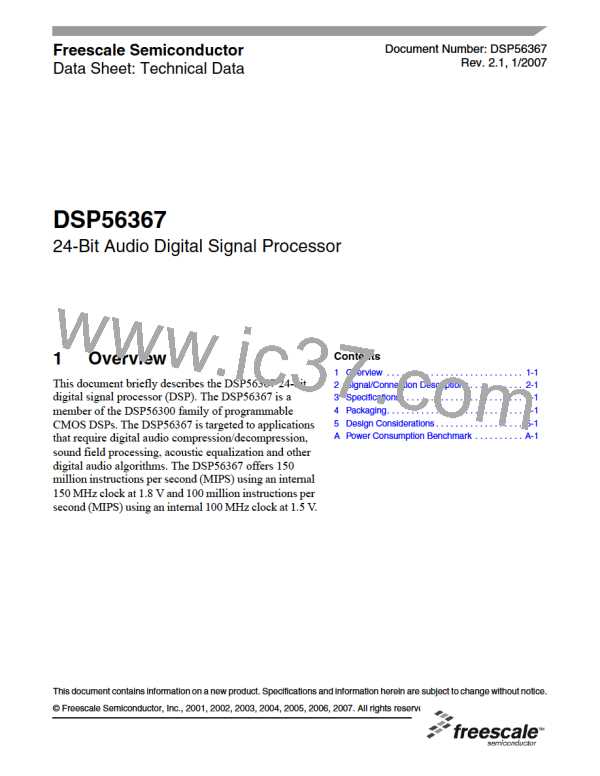Serial Host Interface
Table 2-10 Serial Host Interface Signals (continued)
Signal
Name
Signal
Type
State During
Signal Description
Reset
MOSI
Input or
Output
Tri-Stated
SPI Master-Out-Slave-In—When the SPI is configured as a master, MOSI is the
master data output line. The MOSI signal is used in conjunction with the MISO
signal for transmitting and receiving serial data. MOSI is the slave data input line
when the SPI is configured as a slave. This signal is a Schmitt-trigger input when
configured for the SPI Slave mode.
HA0
Input
Input
Input
I2C Slave Address 0—This signal uses a Schmitt-trigger input when configured for
the I2C mode. When configured for I2C slave mode, the HA0 signal is used to form
the slave device address. HA0 is ignored when configured for the I2C master mode.
This signal is tri-stated during hardware, software, and individual reset. Thus, there
is no need for an external pull-up in this state.
This input is 3.3V tolerant.
SS
Tri-Stated
SPI Slave Select—This signal is an active low Schmitt-trigger input when
configured for the SPI mode. When configured for the SPI Slave mode, this signal
is used to enable the SPI slave for transfer. When configured for the SPI master
mode, this signal should be kept deasserted (pulled high). If it is asserted while
configured as SPI master, a bus error condition is flagged. If SS is deasserted, the
SHI ignores SCK clocks and keeps the MISO output signal in the high-impedance
state.
I2C Slave Address 2—This signal uses a Schmitt-trigger input when configured for
the I2C mode. When configured for the I2C Slave mode, the HA2 signal is used to
form the slave device address. HA2 is ignored in the I2C master mode.
HA2
This signal is tri-stated during hardware, software, and individual reset. Thus, there
is no need for an external pull-up in this state.
This input is 3.3V tolerant.
HREQ
Input or
Output
Tri-Stated
Host Request—This signal is an active low Schmitt-trigger input when configured
for the master mode but an active low output when configured for the slave mode.
When configured for the slave mode, HREQ is asserted to indicate that the SHI is
ready for the next data word transfer and deasserted at the first clock pulse of the
new data word transfer. When configured for the master mode, HREQ is an input.
When asserted by the external slave device, it will trigger the start of the data word
transfer by the master. After finishing the data word transfer, the master will await
the next assertion of HREQ to proceed to the next transfer.
This signal is tri-stated during hardware, software, personal reset, or when the
HREQ1–HREQ0 bits in the HCSR are cleared. There is no need for external pull-up
in this state.
This input is 3.3V tolerant.
DSP56367 Technical Data, Rev. 2.1
2-12
Freescale Semiconductor

 FREESCALE [ Freescale ]
FREESCALE [ Freescale ]